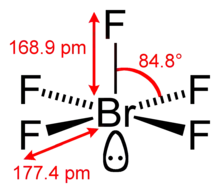Bromine pentafluoride
Bromine pentafluoride, BrF5, is an interhalogen compound and a fluoride of bromine. It is a strong fluorination reagent.
 | |||
| |||
| Names | |||
|---|---|---|---|
| IUPAC name
Bromine pentafluoride | |||
| Identifiers | |||
3D model (JSmol) |
|||
| ChemSpider | |||
| ECHA InfoCard | 100.029.234 | ||
| EC Number |
| ||
PubChem CID |
|||
| RTECS number |
| ||
| UNII | |||
| UN number | 1745 | ||
CompTox Dashboard (EPA) |
|||
| |||
| |||
| Properties | |||
| BrF5 | |||
| Molar mass | 174.894 g.mol−1 | ||
| Appearance | Pale yellow liquid | ||
| Density | 2.466 g/cm3 | ||
| Melting point | −61.30 °C (−78.34 °F; 211.85 K) | ||
| Boiling point | 40.25 °C (104.45 °F; 313.40 K) | ||
| Reacts with water | |||
| Structure | |||
| Square pyramidal | |||
| Hazards | |||
| Main hazards | Reacts violently with water, powerful oxidizer[1] | ||
| Safety data sheet | See: data page External MSDS | ||
| GHS pictograms |     | ||
| GHS Signal word | Danger | ||
| H271, H305, H314, H318, H330, H370, H371, H373 | |||
| P210, P220, P221, P260, P264, P270, P271, P280, P283, P284, P301+310, P301+330+331, P303+361+353, P304+340, P305+351+338, P306+360, P307+311, P309+311, P310, P314, P320, P321, P331, P363, P370+378 | |||
| NFPA 704 (fire diamond) | |||
| Flash point | Non-flammable | ||
| NIOSH (US health exposure limits): | |||
PEL (Permissible) |
none[1] | ||
REL (Recommended) |
TWA 0.1 ppm (0.7 mg/m3)[1] | ||
IDLH (Immediate danger) |
N.D.[1] | ||
| Related compounds | |||
Other anions |
Bromine monochloride | ||
Other cations |
Chlorine pentafluoride Iodine pentafluoride | ||
Related compounds |
Bromine monofluoride Bromine trifluoride | ||
| Supplementary data page | |||
| Refractive index (n), Dielectric constant (εr), etc. | |||
Thermodynamic data |
Phase behaviour solid–liquid–gas | ||
| UV, IR, NMR, MS | |||
Except where otherwise noted, data are given for materials in their standard state (at 25 °C [77 °F], 100 kPa). | |||
| Infobox references | |||
BrF5 finds use in oxygen isotope analysis. Laser ablation of solid silicates in the presence of bromine pentafluoride releases O2 for subsequent analysis.[2] It has also been tested as an oxidizer in liquid rocket propellants and is used as a fluorinating agent in the processing of uranium.
Preparation
Bromine pentafluoride was first prepared in 1931 by the direct reaction of bromine with fluorine.[3] This reaction is suitable for the preparation of large quantities, and is carried out at temperatures over 150 °C (302 °F) with an excess of fluorine:
- Br2 + 5 F2 → 2 BrF5
For the preparation of smaller amounts, potassium bromide is used:[3]
- KBr + 3 F2 → KF + BrF5
This route yields bromine pentafluoride almost completely free of trifluorides and other impurities.[3]
Reactions
Bromine pentafluoride reacts violently with water, but it will form bromic acid and hydrofluoric acid (especially when moderated by dilution with acetonitrile), simple hydrolysis products:[4]
- BrF5 + 3 H2O → HBrO3 + 5 HF
It is an extremely effective fluorinating agent, being able to convert most uranium compounds to uranium hexafluoride at room temperature.
Hazards
Bromine pentafluoride is severely corrosive to the skin, and its vapors are irritating to the eyes, skin, and mucous membranes. In moist air, it will in fact release "smoke" containing hydrofluoric acid vapors coming from its reaction with the water in the air. Additionally, exposure to 100 ppm or more for more than one minute is lethal to most experimental animals. Chronic exposure may cause kidney damage and liver failure.[5]
It may spontaneously ignite or explode upon contact with organic materials or metal dust.[5]
References
- NIOSH Pocket Guide to Chemical Hazards. "#0065". National Institute for Occupational Safety and Health (NIOSH).
- Clayton, R.; Mayeda, T. K. (1963). "The use of bromine pentafluoride in the extraction of oxygen from oxides and silicates for isotopic analysis". Geochimica et Cosmochimica Acta. 27 (1): 43–48. Bibcode:1963GeCoA..27...43C. doi:10.1016/0016-7037(63)90071-1.
- Hyde, G. A.; Boudakian, M. M. (1968). "Synthesis routes to chlorine and bromine pentafluorides". Inorganic Chemistry. 7 (12): 2648–2649. doi:10.1021/ic50070a039.
- Greenwood, Norman N.; Earnshaw, Alan (1997). Chemistry of the Elements (2nd ed.). Butterworth-Heinemann. p. 834. ISBN 978-0-08-037941-8.
- Patnaik, Pradyot (2007). A comprehensive guide to the hazardous properties of chemical substances (3rd ed.). Wiley-Interscience. p. 480. ISBN 0-471-71458-5.
External links
- WebBook page for BrF5
- International Chemical Safety Card 0974
- NIOSH Pocket Guide to Chemical Hazards. "#0065". National Institute for Occupational Safety and Health (NIOSH).
- National Pollutant Inventory - Fluoride and compounds fact sheet


